Ballarat Botanical Gardens Statues

Twelve statues depicting Greek and Roman deities, known as the Stoddart Collection, were crafted from the finest marble quarried at Carrara, Tuscany and now reside in the Ballarat Botanical Gardens.
Thomas Stoddart bought 12 white marble statues during a visit to Italy. Stoddart arranged for them to be shipped to Victoria and placed on pedestals of Sicilian marble with Grampians granite bases. When Thomas Stoddart presented the white marble statues as a gift to the public gardens of Ballarat in 1884, it was his hope that the statues would cultivate in the community an appreciation for beauty and art.
Stoddart statues
THOMAS STODDART 1828-1905
In 1884 Thomas Stoddart presented 12 white marble statues to adorn the public gardens of Ballarat. That collection is now more than 140 years old, still intact, and very much valued. They are situated along the paths among the trees and garden beds.
The statues are of the finest marble quarried at Carrara, a coastal town at the foot of the marble mountains of the Apuan Alps in NW Tuscany. A 2000-year tradition which began in Roman times was climaxed during the Renaissance when many of the word's most famous sculptures were created. The silky texture of Carrara marble allows the artist to fashion exquisite detail with a lustrous finish.
While visiting a sculptors' studio in Italy, Thomas Stoddart saw classical statues being made for the gardens in Genoa. He thought, "Why should not the gardens at Ballarat be similarly adorned?" On impulse, as goldmen of the day did, he ordered a dozen on the spot. The sculptures are three-quarter human size and depict deities from the realms of Greek and Roman mythology. It was the intention of the donor that the statues would cultivate a love for the beautiful in the hearts of the young people of the district.
Visitors to the gardens were inspired to increase their knowledge and enjoyment of the classics in literature as well as in art. This was regarded as the hallmark of a cultured society whose refined tastes had developed in the Colonies to no greater degree than in the City of Ballarat. Historian W. B Withers remarked that, "None of the public grounds of even the metropolitan cities of Australia are graced with marble statues in such profusion as are the Botanical Gardens of Ballarat."
The Stoddart Statue Collection represents four studios of Italian artists: Angelo Bertozzi fashioned the seasons, Mercury and Hercules; B. Raggi created Hebe, Leda and Pomona; and G Marchetti made Flora. Giovanni (John) Udny (1850-1927), the sculptor of Bacchante and Flora Farnese, was a descendant of a Scottish-born British Vice-Consul of Italy and he learned his genius with marble from an Italian uncle who was a marble merchant (Stoddart was born in Scotland).
Experience the glory of all four seasons in nature and in art in Ballarat's gardenesque style, cool climate garden. Pass the glass prism that is the Conservatory and the mature Turkey Oak into the Prime Ministers Avenue and beyond into the Chestnut Avenue to see these sculptures.
1. Spring
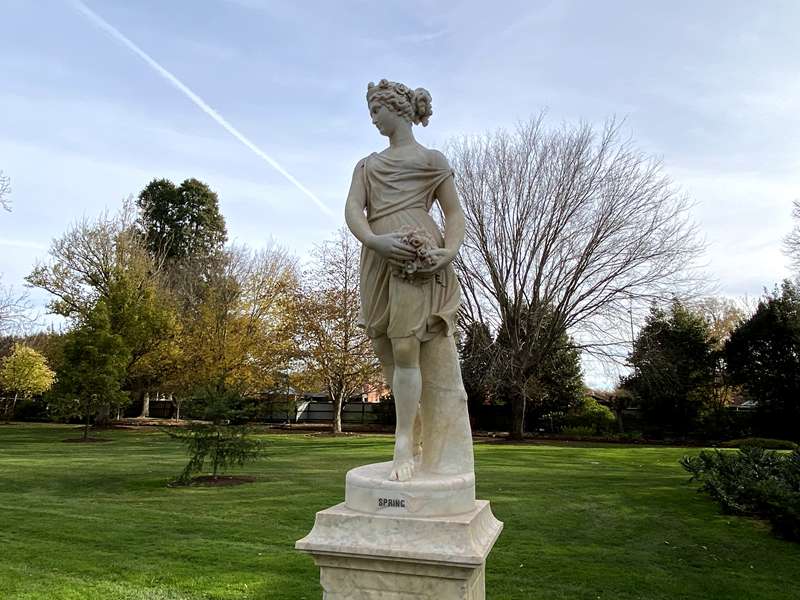
Spring is a maiden wearing a toga dress and has a floral wreath on head and carrying a posy. Beside a Bunya Bunya pine, this young woman has a fresh look, crowned with a floral wreath and carrying a posy. Her flattering one-shoulder toga dress is a style of Greco-Roman inspired goddess gowns which fashion designers periodically revive. In ancient times the welcome return of spring was celebrated with lengthy pagan festivals. Christians followed suit.
2. Summer
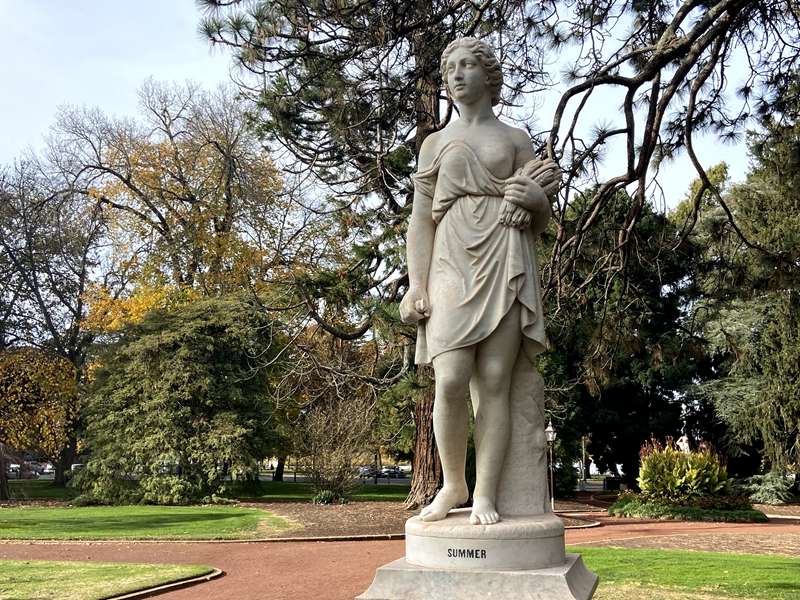
Summer with handle of sickle and holding a sheaf of grain, symbolising harvest time.
The lyricist sings of summer pleasures:
The town's pale denizens come forth to breathe
The free fresh air, and lave their fevered brows.
And beauty loves young flowers to wreathe
Beneath some stately forest's antique brows
Oh, art hath naught like this, the very air
Breatheth of beauty banishing despair.
3. Autumn
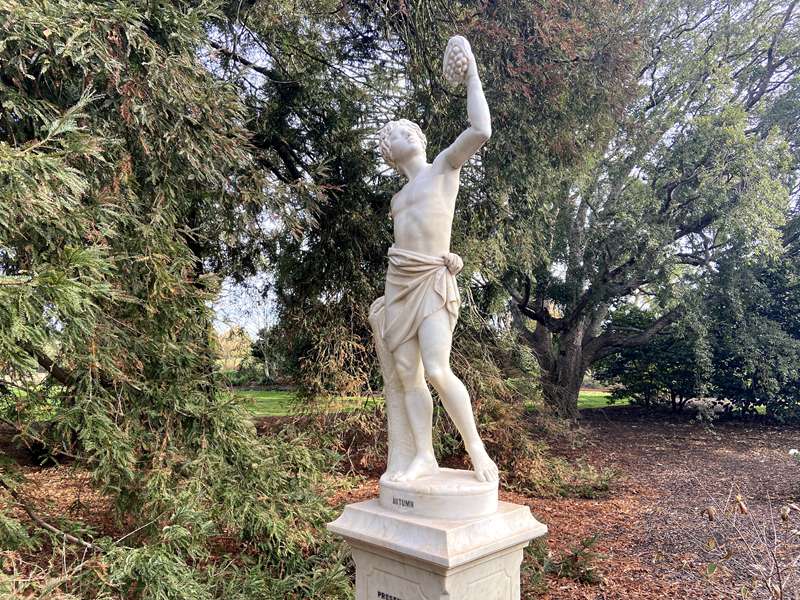
Autumn is holding a bunch of grapes symbolic of the vintage. A bare chested youth who yields the juice of the luxuriant grape to spread good cheer and gladden hearts.
4. Winter

Wizened old man protecting himself again the winter chills. Located near the sensory garden fountain, an elderly gentleman with shrivelled limbs and white hoary locks, stooping, with his robe tightly drawn against the chill.
5. Flora Farnese
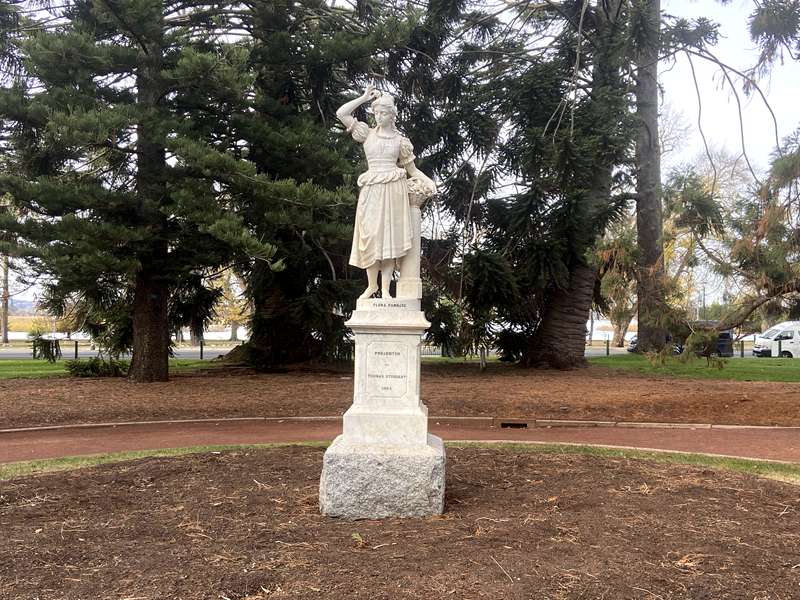
In a bed of salvias, this statue is another portrayal of the Roman flower goddess Flora, goddess of spring, named after one from the noble Farnese family, shown here wearing a ruched blouse with short puffed sleeves under a fitted bodice. The skirt features exaggerated gathering at the hip with graceful folds to a flattering below the knee hemline, trimmed with a double row of pintucking. She is placing a flower in her hair from a basket of blooms on a pedestal.
6. Leda
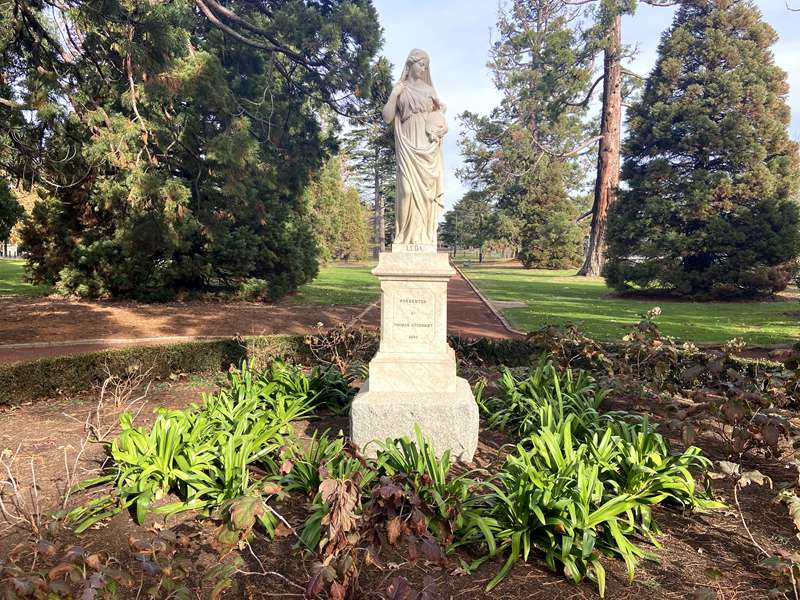
Leda, in a bed of euphorbias, was the wife of the king of Sparta who was seduced by Zeus in the guise of a swan. Those who delve into classical lore will find that the story of Leda is just one of many rollicking good yarns of intrigue, infidelity, violence and worse. Let's be polite and just say that Zeus loved Leda and came to her in the form of a swan.
7. Hebe
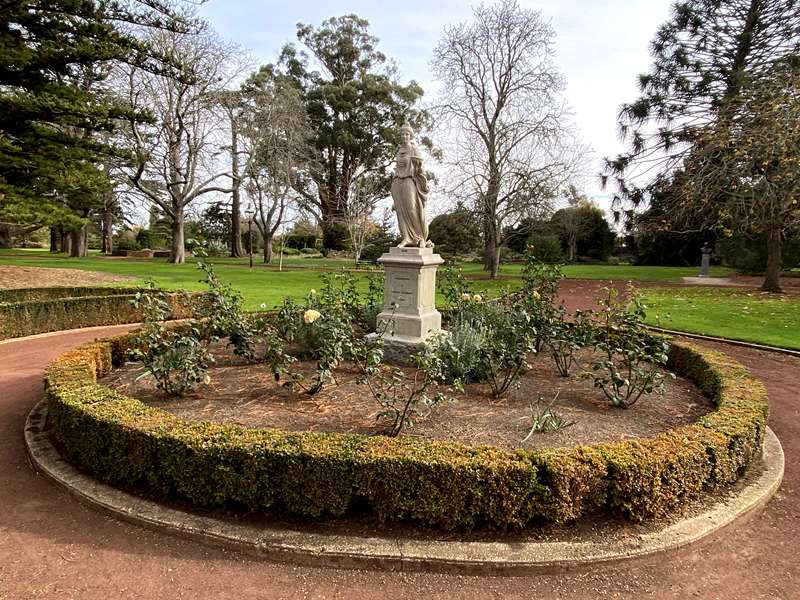
Greek goddess of eternal youth with the power to restore to age the vigour of youth and was cup-bearer to the gods. Hebe, in a circular bed of roses, is shown in an elegant flowing gown, bearing a cup and a pitcher to serve ambrosia and nectar to the gods on Mount Olympus.
8. Mercury
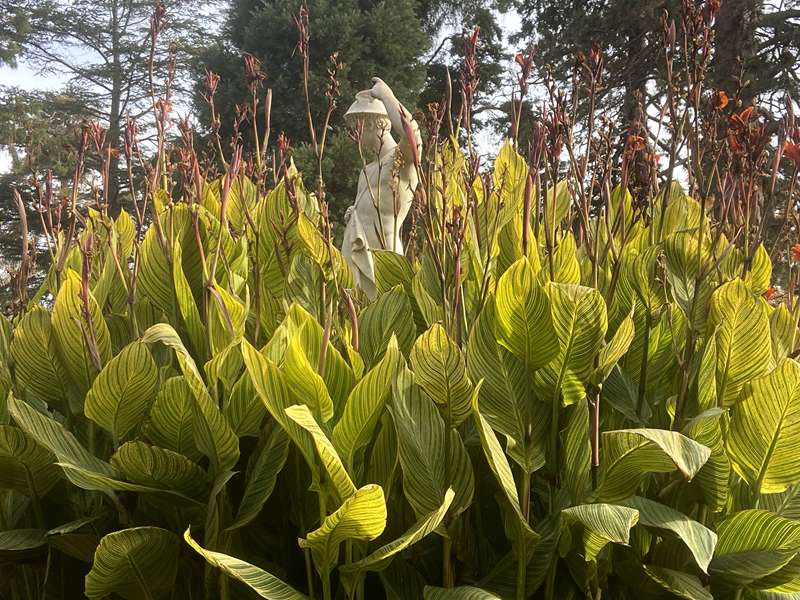
Messenger of the gods shown with winged helmet and pouch. A youthful god in a winged helmet, messenger of the gods and the centrepiece for the ceremony on the 24th of March 1884, the 65th birthday of Queen Victoria. The newspapers reported that there was some confusion about the proclamation of this holiday due to the lamented death of King Leopold. "As it is, the action of the City Council has deprived the citizens generally of participating in the celebration at the Botanical Gardens to-day, as many of them had to take their holiday yesterday" Even so, some 1000 spectators saw the main party arrive at the Lawn landing after a processional flotilla of steamers, yachts (including the 4 ton Pinafore owned by Stoddart) and rowing boats, slowly paraded around the southern shore of Lake Wendouree to the Gardens
Disembarked dignitaries crossed the road to a covered statue in a circular enclosure. Foot constables dealt with an orderly crowd and the newly-formed 100-strong Militia brass band marched in to soul-inspiring strains for the presentation ceremony. The drapery was tenderly removed with a pole, disclosing the near-nude figure of Mercury to the enraptured gaze of the spectators. As the god of merchants and commerce, orators and travellers, as well as thieves and pickpockets, this one would attract many admirers.
Mr Stoddart, in presenting his gift to the City Council, said, "I hope that the people of Ballarat will receive this gift with as much pleasure as it has afforded me in making the presentation." A diminutive cannon was then fired as a signal to unveil the statues situated in various parts of the Botanical Gardens. The Militia band chimed in with the National Anthem, and three rousing cheers were given in honour of Her Majesty the Queen. Mayor J. Hickman and the Hon. Major W. C. Smith MLA responded with words of praise for the donor and the last speaker, Cr F. M. Claxton, called for three cheers for Mr Stoddart and the spectators made the heavens ring with applause. The assemblage then scattered to view the remainder of the statues, which were intently studied, and called forth pleased comment. It was agreed that the best judgement had been shown in the selection of sites.
That night Mr Stoddart was the toast of the town at a grand dinner at Craig's Royal Hotel. His splendid gift was the first which inspired other wealthy men to generously support the movement to make Ballarat the "City of Statues."
9. Hercules

Greek hero of great strength and courage wearing his lion skin as a trophy and massive club. Killed his children and had to achieve atonement performing twelve special labours. Be sure to look behind for the lion's head and tail and, ahem, the not unattractive buttocks of this mortal/god of long ago who rescued hapless maidens in distress.
10. Bacchante
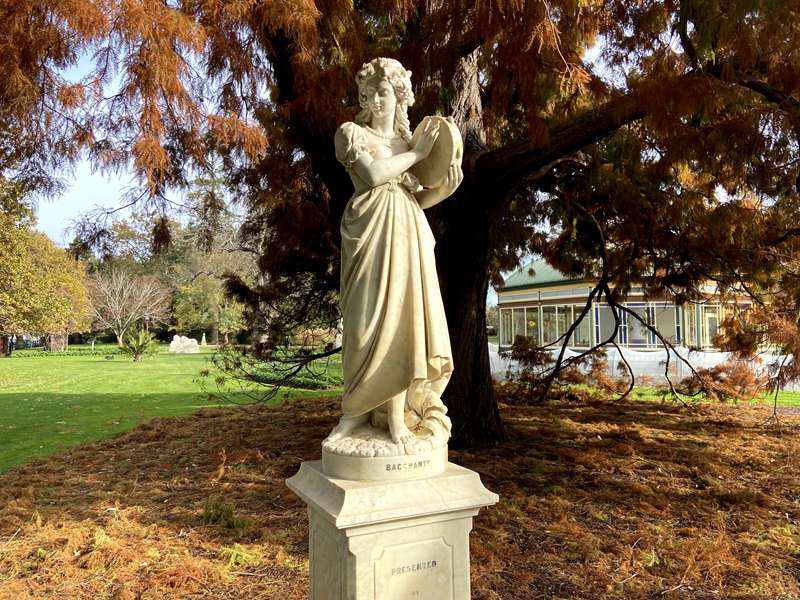
Priestess to Bacchus, God of wine and good times, and so associated with wild orgies. With a backdrop of Swamp Cypress, priestess of Bacchus, ever fair, ever young, bejewelled and playing on a tambourine. The festivals of the Roman Bacchante were joyful, unruly dance parties. Think wild women in the woods, debauchery and revelry.
11. Flora
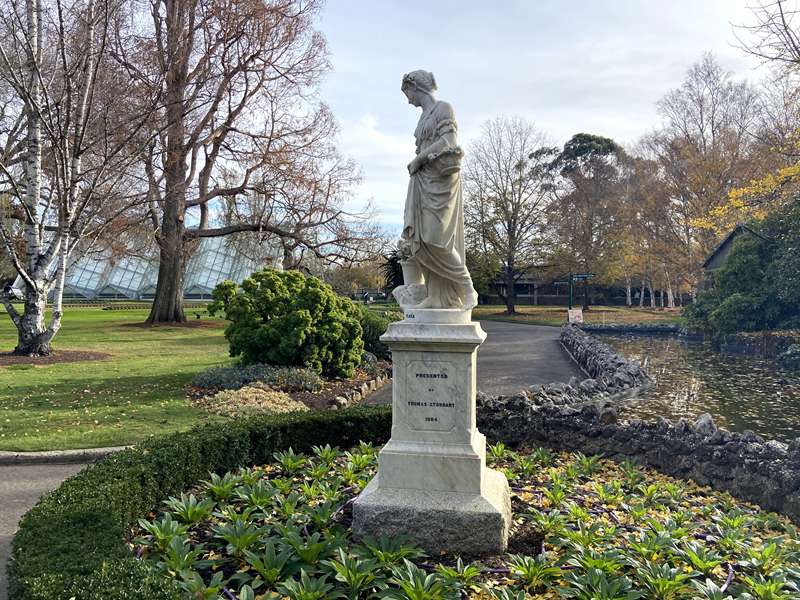
Roman goddess of flowers is watering flowers at her feet and is dressed in a classical garment. Flora is considered by many to be the masterpiece of the twelve because of the fine detail which creates such a pretty picture in stone. This portrayal of the Roman goddess of flowers shows her watering a pot of luscious blooms with a basket of flowers on her arm. Her position is a highly visible one between the Statuary Pavilion and the fernery pond.
12. Pomona
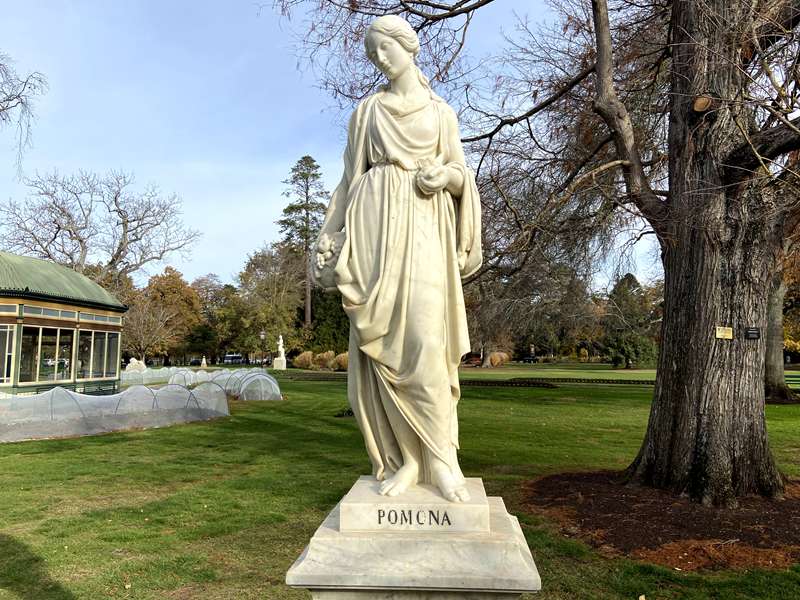
Roman Goddess of fruit trees and her care for their cultivation brings fruitful abundance.
Pomona, Roman goddess of gardens and orchards as well as all fruit trees.
Her name, Pomona, from her woodland race,
In garden culture none could her excel,
Or form the pliant soul of plants so well,
Or to the fruit more generous favors lend,
Or teach the trees with nobler loads to bend.
Other statues
Sir William Wallace
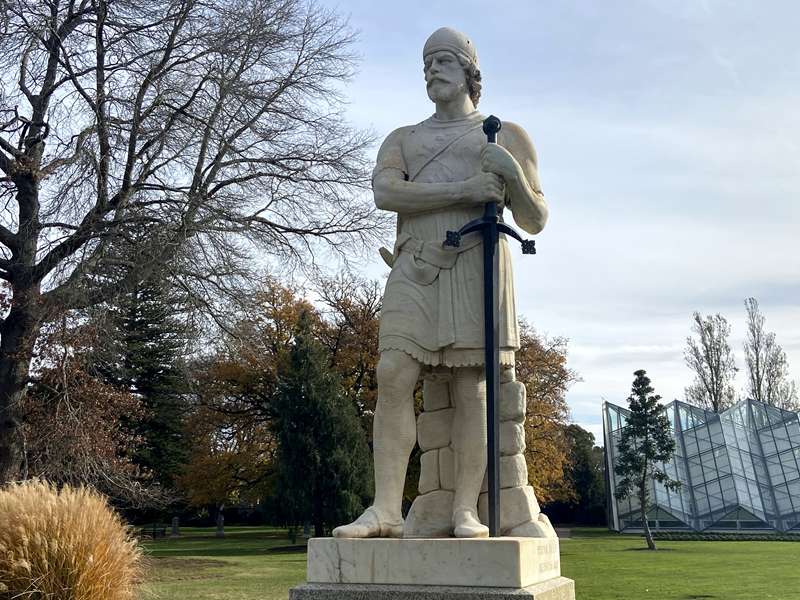
Thomson was born in Scotland in 1818 and arrived in Australia in 1852. The Wallace statue is a tribute to his Scottish ancestry. At the time of its unveiling the statue was claimed to be the biggest that had been made south of the equator. Wallace is depicted standing on Abbey Craig at Stirling in 1297, waiting for the British to cross Stirling Bridge. He has to decide the right moment for a horn to be sounded as a signal for his forces to fall upon the enemy. With the defeat of the British forces, Wallace became recognised as a great Scottish hero.
Lion Statues
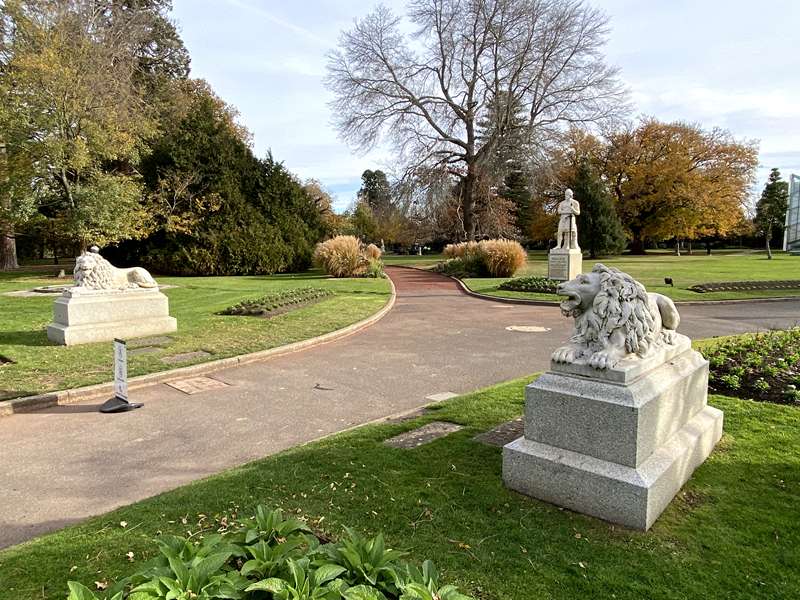
David Ham 1830 - 1908
David Ham MLC donated the two marble lions in 1893. These were characteristic of grand entrances in 19th Century landscapes and the lions were also an emblem of the strength of the British nation.
Statuary House for Thomson Statues
The statuary Pavilion, in 1888, was designed by Ballarat architect T.E. Molloy and is of national historic and architectural significance. It is unusual for its top-lit central lantern and curved roofs. The statues are seen to their best advantage because of the provision of all-round and top natural lighting.
Encouraged by the gift of the Stoddart statues, James Russell Thomson left a bequest from which the collection in the Statuary House was purchased, together with that of Wallace, the Scottish hero which stands nearby. While the Stoddart collection was sculptured by Italian artists, those of the Thomson collection were by Australians. Presented on 3rd August 1888, they comprise the 'Flight from Pompeii' with four bas-reliefs, and Susannah, Ruth. Rebekah and Modesty.
'Flight from Pompeii', a white marble statue of a male, female and baby (family) in flight, was designed by Professor Carlo Benzoni and carved by Charles Francis Summers. The other white marble statues were designed and carved by Charles Francis Summers.
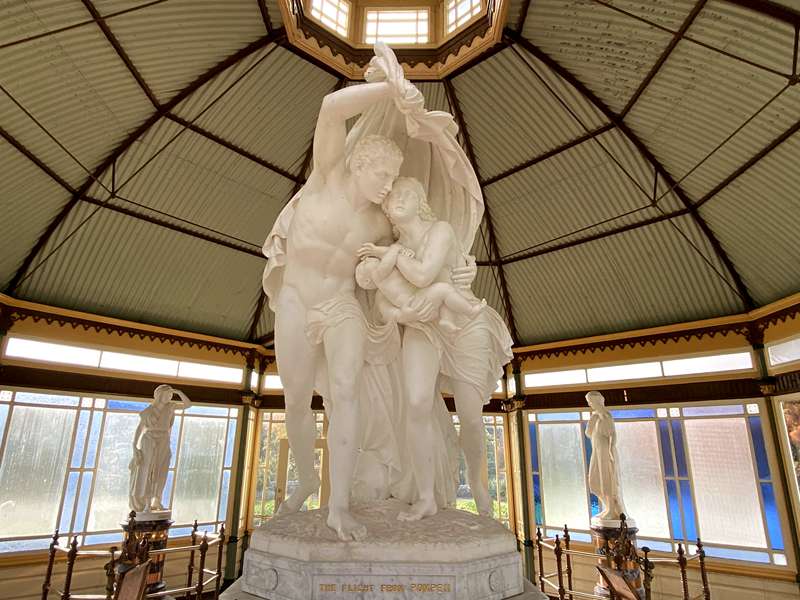
Ruth is in a seated position with a loosely draped dress.
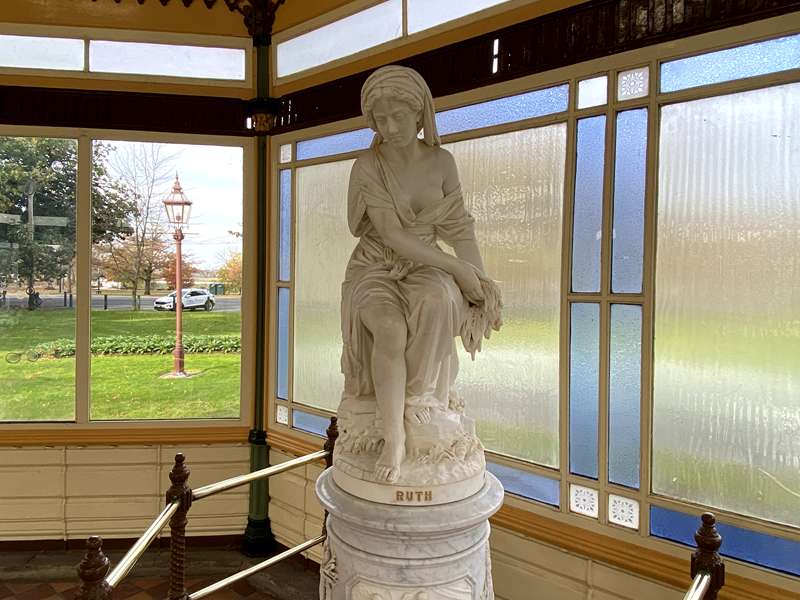
Rebekah is a woman standing with left arm raised to her head and draped in cloth to form a robe tied at the front.

Modesty is standing with right arm folded over chest, robed and with veil over face.
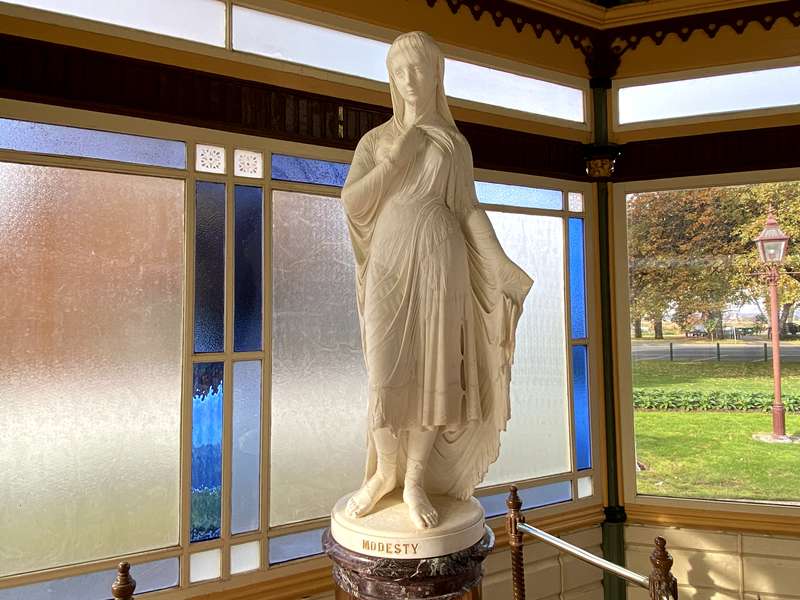
Susannah is a female seated with cloth draped over lower body.
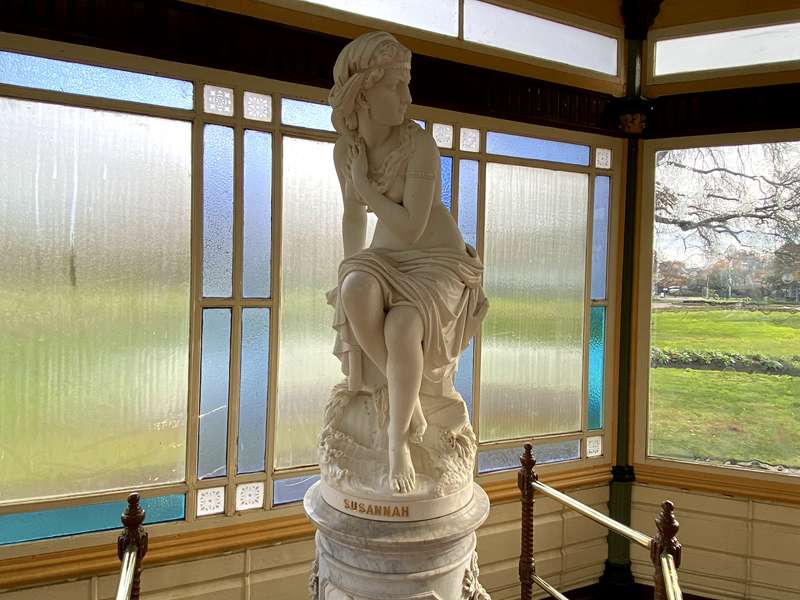
Claxton Memorial

The Claxton Memorial consists of a white marble bust and pedestal set on a cement rendered base with pressed cement dolphins, the whole being set on a basalt plinth in a rendered brickwork pond surrounded by a wrought iron fence.
Prime Ministers Avenue
Bronze busts mounted on polished granite pedestals along Prime Ministers Avenue, an avenue of horse chestnuts in the Ballarat Botanical Gardens, commemorate each Australian Prime Minister. The first six busts were created by Wallace Anderson in co-operation with Mr. Harold Herbert and were unveiled by the Governor, Sir Winston Duggan in 1940.
The avenue began with a bequest from Colonel R. A. Crouch, a Federal politician, soldier and arts patron. The busts are arranged in order of the Prime Minister's first term of office. The avenue is kept up to date with new Prime Ministers. As of 2025, there were busts of the first twenty-nine prime ministers of Australia (up to Malcom Turnbull). Scott Morrison and Anthony Albanese are the only prime ministers who don't have a bust.
Wallace Anderson created the first twelve busts from 1939 to 1943 and was later commissioned for the thirteenth and fourteenth. Ken Palmer, Victor Greenhalgh, Peter Nicholson, and Linda Klarfeld were later sculptors for the Avenue. After the Crouch fund was exhausted in 2014 with Julia Gillard's bust, the Ballarat City Council has been financing the Avenue. The busts have also been subject to repeated vandalism and theft over the decades. In January 2025, the heads of Paul Keating and Kevin Rudd were removed with an angle grinder, while 18 other busts were damaged in an act of vandalism. These have now been replaced and repaired.
1st Edmund Barton / 2nd Alfred Deakin / 3rd Chris Watson / 4th George Reid
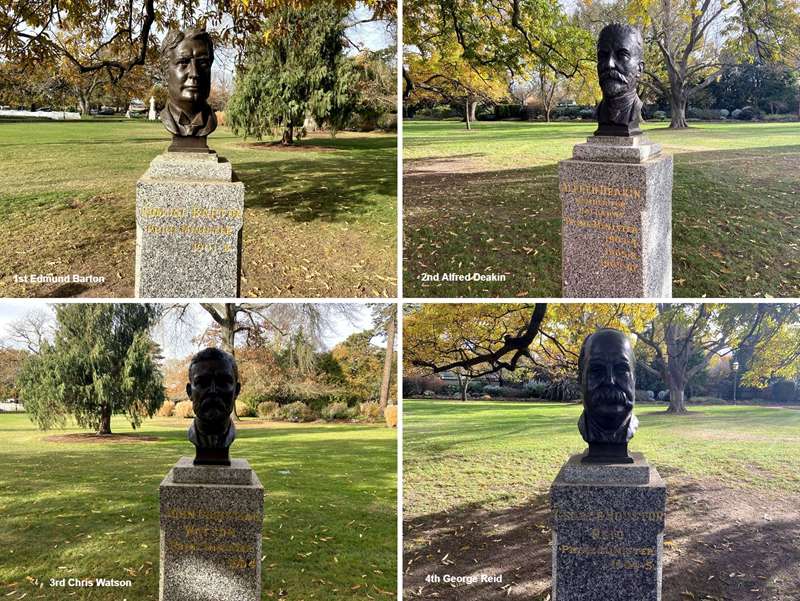
5th Andrew Fisher / 6th Joseph Cook / 7th Billy Hughes / 8th Stanley Bruce
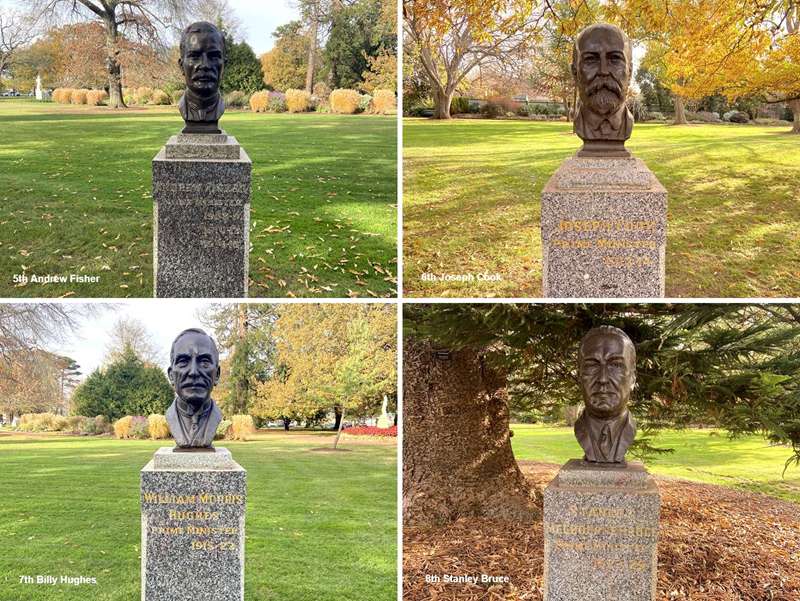
9th James Scullin / 10th Joseph Lyons / 11th Earle Page / 12th Robert Menzies
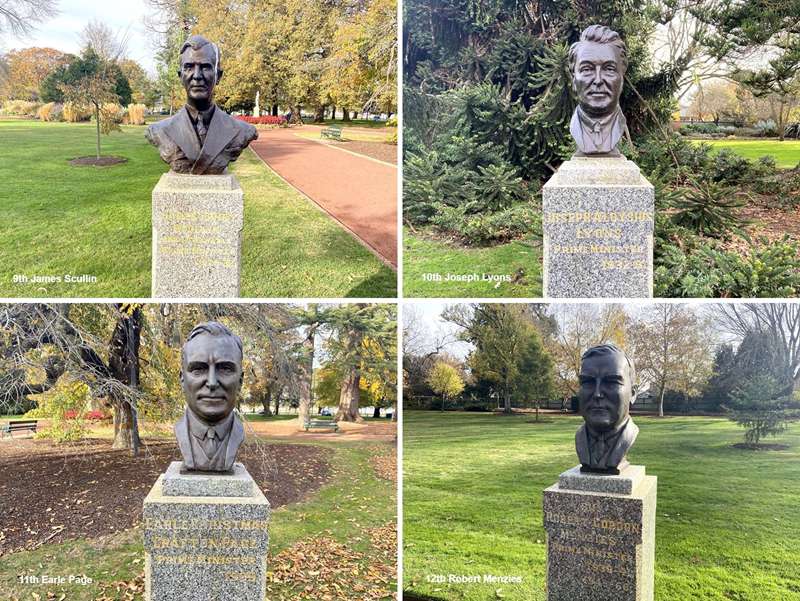
13th Arthur Fadden / 14th John Curtin / 15th Frank Forde / 16th Ben Chifley
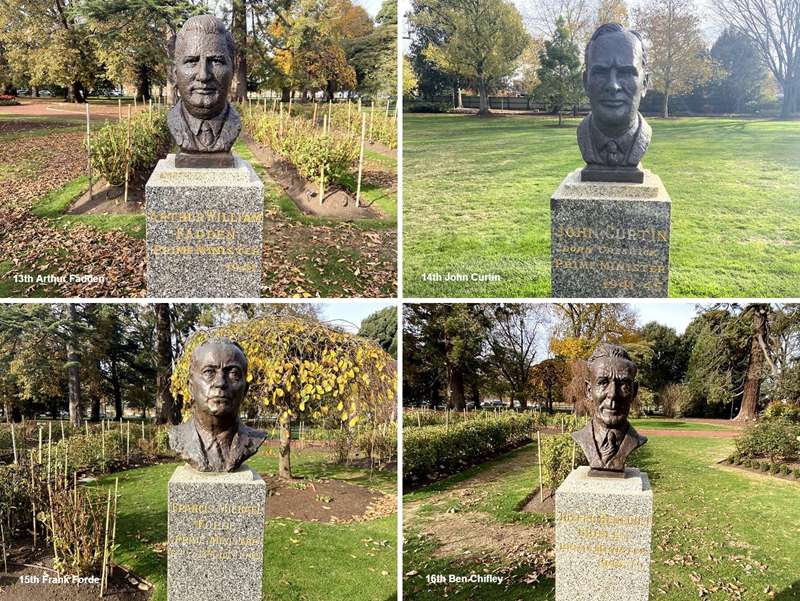
17th Harold Holt / 18th John McEwen / 19th John Gorton / 20th William McMahon
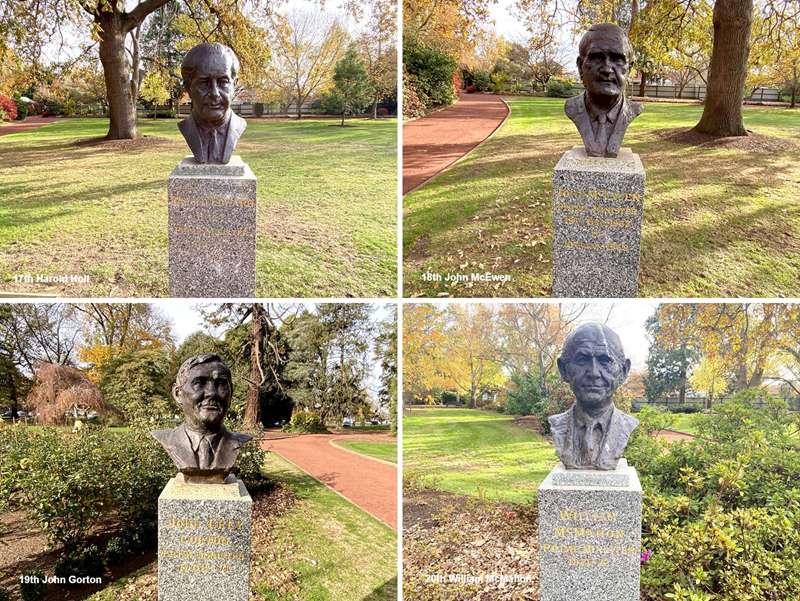
21st Gough Whitlam / 22nd Malcolm Fraser / 23rd Bob Hawke / 24th Paul Keating
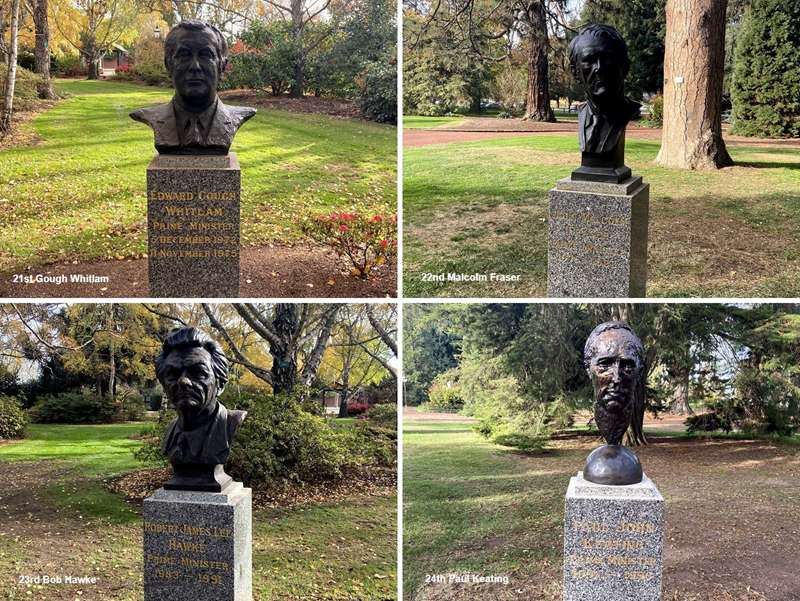
25th John Howard / 26th Kevin Rudd / 27th Julia Gillard / 28th Tony Abbott
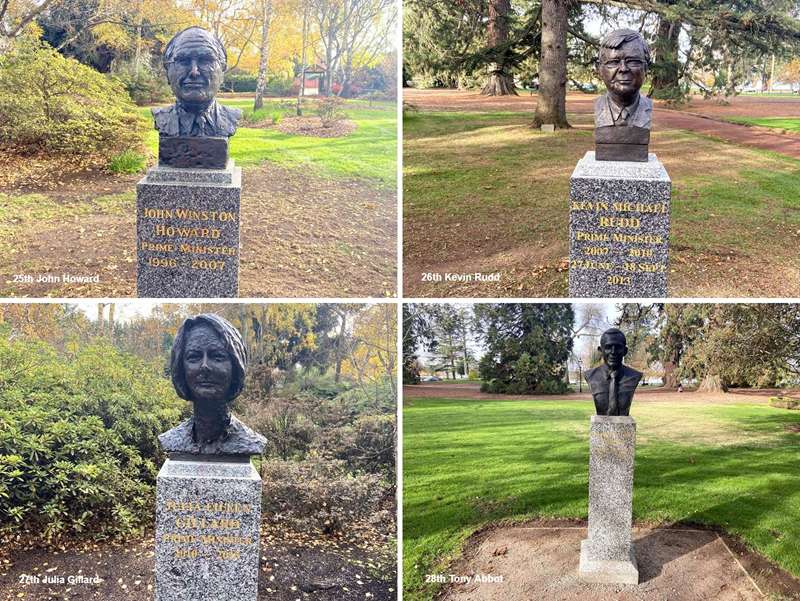
29th Malcolm Turnbull
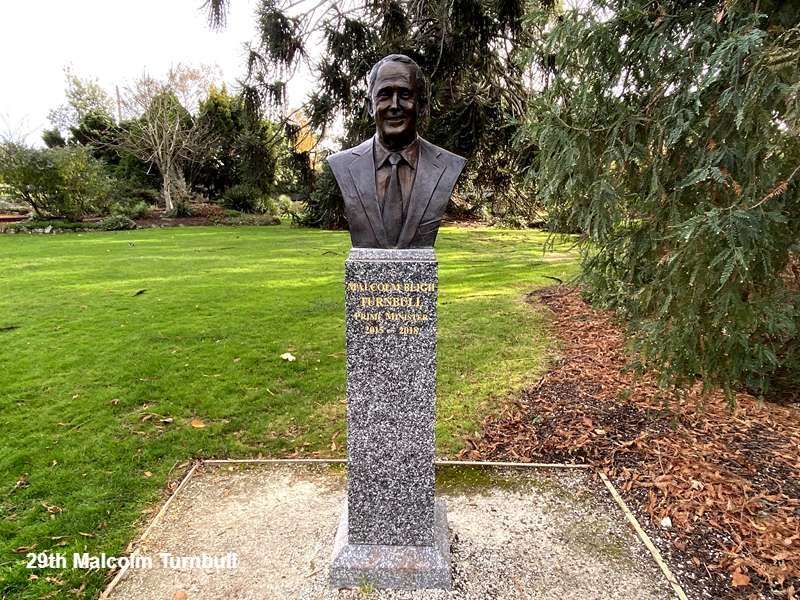
Information from Friends of the Ballarat Botanical Gardens
Location
405 Wendouree Parade, Lake Wendouree 3350 View Map
Web Links
→ Australian Prime Ministers









